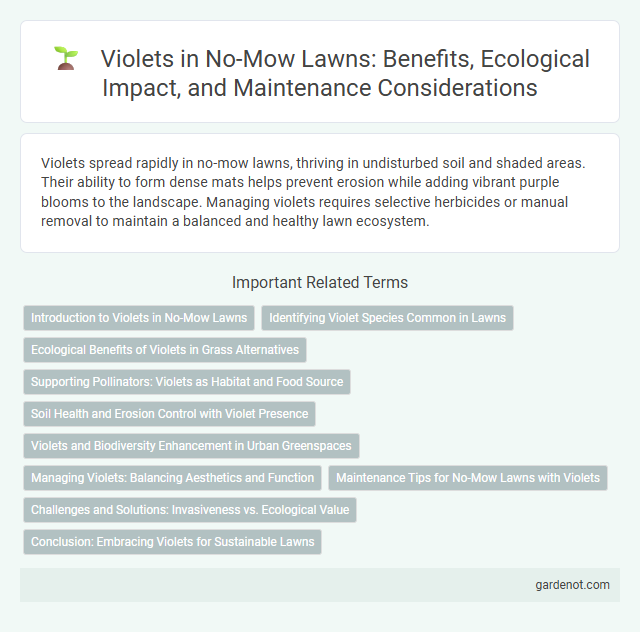Violets spread rapidly in no-mow lawns, thriving in undisturbed soil and shaded areas. Their ability to form dense mats helps prevent erosion while adding vibrant purple blooms to the landscape. Managing violets requires selective herbicides or manual removal to maintain a balanced and healthy lawn ecosystem.
Introduction to Violets in No-Mow Lawns
Violets in no-mow lawns offer a low-maintenance ground cover that thrives with minimal intervention, providing vibrant purple blooms during spring and early summer. Their deep root systems help prevent soil erosion while supporting pollinators such as bees and butterflies, enhancing biodiversity in urban and suburban landscapes. Incorporating violets into no-mow lawns promotes sustainable gardening practices by reducing water usage, mowing frequency, and chemical inputs.
Identifying Violet Species Common in Lawns
Violets commonly found in no-mow lawns include Viola sororia (common blue violet), Viola papilionacea, and Viola pratincola, each exhibiting heart-shaped leaves and five-petaled flowers. Identification focuses on leaf shape, flower color ranging from deep purple to blue or white, and growth patterns such as spreading via rhizomes or stolons. Accurate species identification aids effective management and enhances the biodiversity benefits of no-mow lawn practices.
Ecological Benefits of Violets in Grass Alternatives
Violets thrive in no-mow lawns by naturally suppressing weed growth and supporting pollinators such as bees and butterflies, enhancing local biodiversity. Their deep root systems improve soil health, increase aeration, and promote water retention, making them an eco-friendly alternative to traditional grasses. Incorporating violets reduces the need for fertilizers and pesticides, leading to sustainable landscaping with fewer environmental impacts.
Supporting Pollinators: Violets as Habitat and Food Source
Violets play a crucial role in supporting pollinators by providing essential habitat and a rich food source for various species, including butterflies and bees. Their early spring blooms offer nectar and pollen when few other plants are flowering, promoting pollinator health and biodiversity in no-mow lawns. Maintaining violets within natural grass areas encourages sustainable ecosystems and enhances pollinator populations vital for garden and agricultural productivity.
Soil Health and Erosion Control with Violet Presence
Violets naturally thrive in no-mow lawns, enhancing soil health by improving organic matter content and supporting beneficial microbial activity. Their dense root systems help stabilize the soil, significantly reducing erosion on slopes and bare patches. The presence of violets promotes moisture retention, fostering a resilient, erosion-resistant lawn ecosystem.
Violets and Biodiversity Enhancement in Urban Greenspaces
Violets serve as vital ground cover in no-mow lawns, promoting biodiversity enhancement by providing nectar and habitat for diverse pollinators such as bees and butterflies in urban greenspaces. Their dense foliage suppresses invasive weeds and improves soil health through natural nitrogen fixation, supporting ecosystem resilience. Integrating violets into urban lawn management fosters sustainable green infrastructure and enriches local flora and fauna diversity.
Managing Violets: Balancing Aesthetics and Function
Managing violets in a no-mow lawn involves careful balancing between preserving their natural beauty and maintaining functional grass areas. Regular monitoring and targeted trimming prevent excessive spreading while allowing violets to enrich biodiversity and soil health. Strategic control methods, such as spot treatments and mowing adjustments, optimize aesthetic appeal without compromising the lawn's ecological benefits.
Maintenance Tips for No-Mow Lawns with Violets
Violets thrive in no-mow lawns due to their low growth habit and shade tolerance, making them ideal for eco-friendly landscaping. To maintain a healthy no-mow lawn with violets, regular watering during dry spells and occasional overseeding help support dense coverage and prevent weed invasion. Controlling soil fertility by reducing nitrogen levels encourages violet growth while discouraging aggressive grass species, ensuring a balanced, low-maintenance lawn ecosystem.
Challenges and Solutions: Invasiveness vs. Ecological Value
Violets often spread aggressively in no-mow lawns, posing challenges due to their invasive nature and rapid coverage that can outcompete desired grasses. However, their ecological value lies in supporting pollinators like butterflies and enhancing soil health, making their management crucial rather than elimination. Solutions include targeted manual removal and selective herbicides applied carefully to preserve pollinator habitats while controlling violet proliferation.
Conclusion: Embracing Violets for Sustainable Lawns
Violets contribute to sustainable lawns by enhancing biodiversity and requiring minimal maintenance compared to traditional grass species. Their natural resilience and ability to thrive in varied soil conditions reduce the need for chemical fertilizers and frequent mowing. Embracing violets supports eco-friendly landscaping practices while creating vibrant, low-maintenance green spaces.
Violets spread Infographic

 gardenot.com
gardenot.com